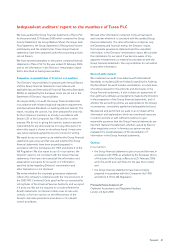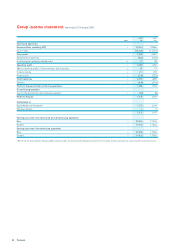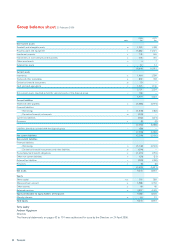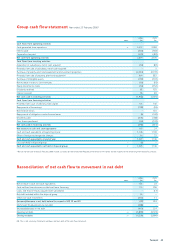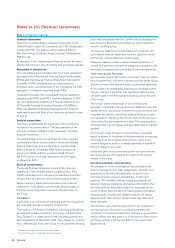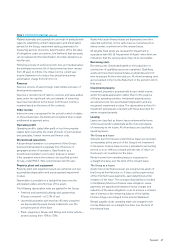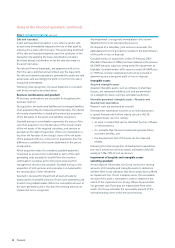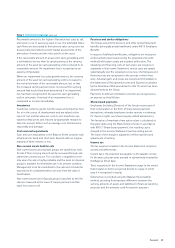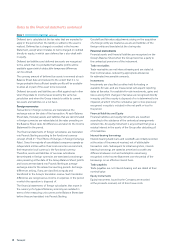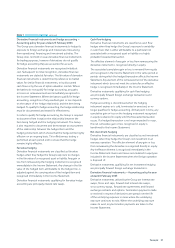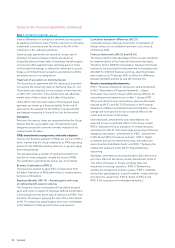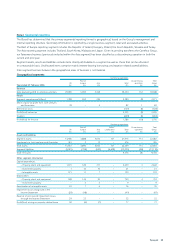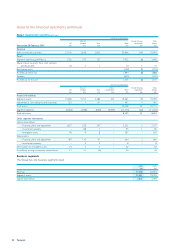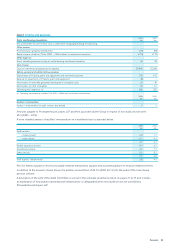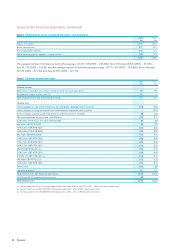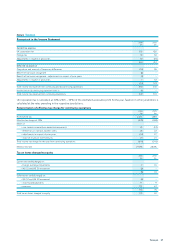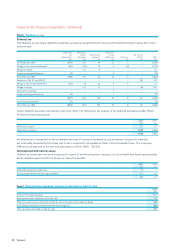Tesco 2006 Annual Report Download - page 53
Download and view the complete annual report
Please find page 53 of the 2006 Tesco annual report below. You can navigate through the pages in the report by either clicking on the pages listed below, or by using the keyword search tool below to find specific information within the annual report.
51Tesco plc
Note 1 Accounting policies continued
Derivative financial instruments and hedge accounting –
Accounting policy for year ended 25 February 2006
The Group uses derivative financial instruments to hedge its
exposure to foreign exchange and interest rate risks arising
from operational, financing and investment activities. The
Group does not hold or issue derivative financial instruments
for trading purposes, however if derivatives do not qualify
for hedge accounting they are accounted for as such.
Derivative financial instruments are recognised initially at
cost. Subsequent to initial recognition, derivative financial
instruments are stated at fair value. The fair value of derivative
financial instruments is determined by reference to market
values for similar financial instruments, or by discounted
cash flows or by the use of option valuation models. Where
derivatives do not qualify for hedge accounting, any gains
or losses on remeasurement are immediately recognised in
the Income Statement. Where derivatives qualify for hedge
accounting, recognition of any resultant gain or loss depends
on the natureof the hedge relationship and the item being
hedged. To qualify for hedge accounting, the hedge relationship
must be documented and tested for effectiveness.
In order to qualify for hedge accounting, the Group is required
to document from inception the relationship between the
item being hedged and the hedging instrument. The Group
is also required to document and demonstrate an assessment
of the relationship between the hedged item and the
hedging instrument, which shows that the hedge will be highly
effective on an ongoing basis. This effectiveness testing is
performed at each period end to ensure that the hedge
remains highly effective.
Fair value hedging
Derivativefinancial instruments are classified as fair value
hedges when they hedge the Group’sexposure to changes
in the fair value of a recognised asset or liability. Any gain or
lossfrom remeasuring the hedging instrument is recognised
immediately in the Income Statement. Any change in the fair
value of the hedged item, attributable to the hedged risk, is
adjusted against the carrying value of the hedged item and
recognised immediately in the Income Statement.
Derivative financial instruments qualifying for fair value hedge
accounting areprincipally interest rate swaps.
Cash flow hedging
Derivative financial instruments are classified as cash flow
hedges when they hedge the Group’s exposure to variability
in cash flows that is either attributable to a particular risk
associated with a recognised asset or liability or a highly
probable forecasted transaction.
The effective element of any gain or loss from remeasuring the
derivative instrument is recognised directly in equity.
The associated cumulative gain or loss is removed from equity
and recognised in the Income Statement in the same period or
periods during which the hedged transaction affects the Income
Statement. Any element of the remeasurement of the derivative
instrument which does not meet the criteria for an effective
hedge is recognised immediately in the Income Statement.
Derivative instruments qualifying for cash flow hedging
are principally forward foreign exchange transactions and
currency options.
Hedge accounting is discontinued when the hedging
instrument expires or is sold, terminated or exercised, or no
longer qualifies for hedge accounting. At that point in time, any
cumulative gain or loss on the hedging instrument recognised
in equity is retained in equity until the forecasted transaction
occurs. If a hedged transaction is no longer expected to occur,
the net cumulative gain or loss recognised in equity is
transferred to the Income Statement.
Net investment hedging
Derivative financial instruments are classified as net investment
hedges when they hedge the Group’s net investment in an
overseas operation. The effective element of any gain or loss
from remeasuring the derivative is recognised directly in equity.
Any ineffective element is recognised immediately in the
Income Statement. Gains and losses accumulated in equity are
included in the Income Statement when the foreign operation
is disposed of.
Derivativeinstruments qualifying for net investment hedging
areprincipally forward foreign exchange transactions.
Derivative financial instruments – Accounting policy for year
ended 26 February 2005
Derivative instruments utilised by the Group are interest rate
swaps, floors and caps, forward start interest rate swaps,
cross currency swaps, forward rate agreements and forward
exchange contracts and options. Termination payments made
or received in respect of derivatives are spread over the life
of the underlying exposurein cases where the underlying
exposure continues to exist. Where the underlying exposure
ceases to exist, any termination payments are taken to the
Income Statement.


